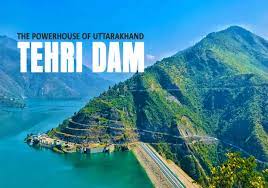
After Joshimath, Several Other Areas in Uttarakhand, Himachal Pradesh Facing Land Subsidence Threat
Manas Dasgupta
NEW DELHI, Jan 14: The Joshimath crisis has brought to the fore the fragile ecology of the Himalayan terrain further disturbed by a proliferation of dams, roads, and military sites near the border with China developed indiscriminately ignoring warnings from the experts.
Not only Uttarakhand, several areas in the neighbouring Himachal Pradesh are also reported to be witnessing cracks in the walls in some villages where people are living in constant fear.
The risks, flagged for decades by environmentalists and activists, came to the fore recently after land subsidence – gradual sinking due to displacement of underground earth layers – led to cracks in hundreds of homes in the tiny town of Joshimath located at an altitude of over 1,830 meters in the northern hill state of Uttarakhand.
The high seismic risk zone is dotted with several picturesque towns and villages that are gateways to hiking trails, Hindu pilgrimage sites, and strategic outposts in India’s lingering border dispute with China. The region is already vulnerable to frequent extreme weather events and landslides. A massive cloudburst in 2013 left more than 5,000 dead in the state.
Four hydropower projects with a combined projected cost of about ₹ 155 billion ($1.9 billion) are currently under construction in Uttarakhand. “The villages and townships in the northern part of Uttarakhand are located along the major active thrust zones within the Himalayas and are very sensitive because of the fragile ecosystem of the region,” said Rajeev Upadhyay, professor of geology at the Kumaun University in Nainital. “Many habitations, which are built on the debris of old landslides, are already under natural stress and man-made constructions are adding further stress to the region.”
Incidents of land sinking in the Joshimath area were reported as early as the 1970s. “If you do a lot of excessive mechanical activities in the region, the land will be prone to slide,” said Mr Upadhyay. “The whole area is vulnerable to subsidence.” Besides Joshimath, cracks are also seen on some houses in Bahuguna Nagar of Karnaprayag in Chamoli district as well as in Tehri near the Tehri Dam, India’s tallest dam and one of the largest hydroelectric power projects. It’s also a popular tourist destination. The project also raised concerns about the environmental problems of locating a large dam in the delicate ecosystem of the Himalayan foothills.
Also facing possible crisis situation is Mana, considered the last village at the border with China, also a key military installation where troop strength was boosted after the latest India-China border stand-off erupted in the summer of 2020. Some troops have been relocated from areas surrounding Joshimath, Army Chief General Manoj Pande, said on Thursday.
Mana is being linked with a national highway, part of a project promoted by Prime Minister Narendra Modi to improve connectivity between pilgrimage sites. Environmental groups have raised concern about the project saying the felling of trees in the wildlife-rich area will increase landslide risks.
The hill town of Dharasu has a landing ground critical for both locals as well as the military for moving troops and material to the disputed Himalayan border. US-made C-130 transporters land in this patch. Similarly Harshil is an important town on the Himalayan pilgrimage route and also used by the military for operations. During the 2013 flash floods, the region was devastated and the town became an important logistical hub for troops to help with evacuation efforts.
In addition Gauchar and Pithoragarh are also in the high risk areas because of the ecological devastations. Gauchar is an important civil and military base about 100 kilometres southwest of Joshimath and just 200 kilometres from the border. The bulk of the Indian Air Force’s rescue and relief efforts in 2013 was staged from this town. Pithoragarh is also an important military and civil hub. Apart from being a large administrative centre, it has an airstrip that can accommodate large aircraft and is crucial to the military.
Alarm bells are also ringing in Himachal Pradesh where at least three villages Nagani, Thalaut and Faagu in Seraj valley of Mandi district have developed cracks in houses sending villagers into a panic.
According to locals, things were normal in these villages till the four-lane project started on the Kiratpur-Manali highway in 2018-19. The cracks started developing from 2020 onwards. The deadline to complete the four-lane project is 2024. At least 32 houses and three temples are among others at risk in these three villages and a few houses have been vacated.
Locals are close to displacement due to the cracks in their houses. According to them, three teams visited the village and assured them of proper compensation but it still eluded them. “What would they be doing with compensation when they are homeless,” a local said. They say whenever it rains, they live in fear and the government hasn’t provided them with safe places despite assurances.
An official said the danger surfaced in 2018 and a survey was carried out too but the result of the assessment was still awaited. ADM, Mandi, Ashwini Kumar, said, “The danger arose from 2018-19 onwards. Cracks in houses emerged due to hill-cutting. We conducted a survey of 10 villages. Scientists have also conducted a survey, and the report is awaited.”














